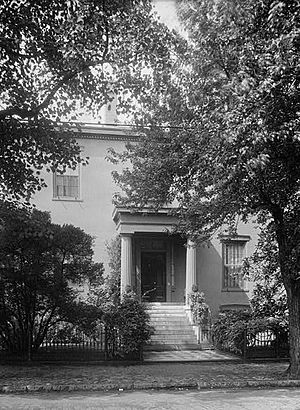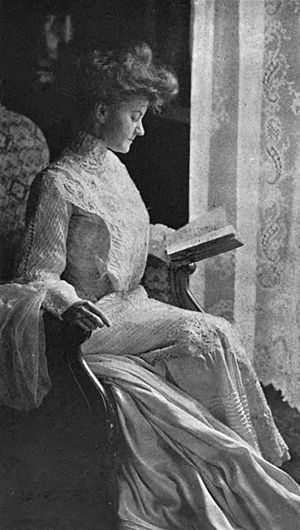Ellen Glasgow facts for kids
Quick facts for kids
Ellen Glasgow
|
|
|---|---|

Portrait of Ellen Glasgow, by Aimé Dupont
|
|
| Born | Ellen Anderson Gholson Glasgow April 22, 1873 Richmond, Virginia, U.S. |
| Died | November 21, 1945 (aged 72) Richmond, Virginia, U.S. |
| Occupation | Novelist |
| Notable awards | Pulitzer Prize for the Novel (1942) |
| Signature | |
Ellen Anderson Gholson Glasgow (born April 22, 1873 – died November 21, 1945) was an American novelist. She won the Pulitzer Prize for the Novel in 1942. Her winning book was called In This Our Life. Ellen Glasgow wrote 20 novels and many short stories. Critics praised her work. She lived in Virginia her whole life. Glasgow showed the changing South in a real way. This was different from other Southern writers. They often wrote about an ideal, dream-like past.
Contents
Ellen Glasgow's Early Life and Family
Ellen Glasgow was born in Richmond, Virginia, on April 22, 1873. Her parents were Anne Jane Gholson and Francis Thomas Glasgow. Ellen was different from other girls in her wealthy family. She had health challenges, later found to be heart disease. Because of this, she studied at home in Richmond. She read many books on philosophy, politics, and literature.
Her parents had ten children. Ellen was the second youngest. Her mother, Anne Gholson, often felt unwell. Ellen also faced similar health issues throughout her life. Ellen thought her father was strict. But some of her strong characters show traits like his. These traits came from his Scottish background.

Ellen Glasgow spent many summers at her family's estate. This was Jerdone Castle in Louisa County, Virginia. Her father bought it in 1879. She later used this setting in her stories.
Her father, Francis Thomas Glasgow, managed the Tredegar Iron Works. This was an important factory in Richmond. It made supplies for the Confederate States of America during the American Civil War.
Ellen Glasgow's Writing Career
Ellen Glasgow wrote for over 40 years. She published 20 novels, a poetry book, and short stories. She also wrote a book of literary criticism. Her first novel, The Descendant, came out in 1897. She wrote it secretly and published it without her name. She was 24 years old. This book was about a woman seeking passion. She did not just want marriage. Her second novel, Phases of an Inferior Planet (1898), showed her name.
Phases of an Inferior Planet was about a marriage facing problems. It also focused on strong female friendships. Critics found the story sad but well-told. Glasgow's third novel was The Voice of People (1900). It looked at poor farmers in politics. The hero was a young Southerner. He became a successful politician.
Her next book, The Battle-Ground (1902), sold over 21,000 copies quickly. It showed the South before and during the American Civil War. People called it the first realistic story of the war from the Southern side.
Many of her books were shaped by her own relationships. The Deliverance (1904) and The Battle-Ground were written during a secret relationship. These are the only early books where the main characters end up together. The Deliverance was her first popular book. It told a love story with class differences. The hero was a rich man who became a worker after the Civil War. The heroine was not from a noble family. But she was educated and refined. Glasgow wanted to show that social class should not stop love. The Deliverance also criticized marriage. Glasgow herself faced social barriers to marrying at that time. The book showed real class struggles after the Civil War.
Glasgow's next four novels had mixed reviews. The Wheel of Life (1906) was set in New York. It was about unhappy home life and love problems. Critics told her to "stick to the South." Glasgow felt this book was not successful.
The Ancient Law (1908) was about factory workers in Virginia. It looked at the rise of factories and their problems. Critics found it too dramatic. With The Romance of a Plain Man (1909) and The Miller of Old Church (1911), Glasgow focused on gender roles. She compared traditional Southern women with feminist ideas. She continued this in Virginia (1913).
In the early 1900s, the women's suffrage movement grew. Glasgow marched in parades in England in 1909. She also spoke at the first suffrage meeting in Virginia. She was an early member of the Equal Suffrage League of Virginia. But her interest in the movement faded. She did not always make women's roles her main topic. She was slow to put heroines at the center of her stories. Some called Virginia (1913), Life and Gabriella (1916), and Barren Ground (1925) her "women's trilogy." Her later heroines showed traits of women in political movements.
Glasgow wrote two more novels, The Builders (1919) and One Man in His Time (1922). She also published short stories in The Shadowy Third and Other Stories (1923). Then she wrote Barren Ground (1925). This book was very important to her.
Barren Ground was written after a romantic relationship ended. It tells the story of a heroine's life. She has a difficult childhood. She looks for comfort in relationships. She gets engaged, but her fiancé leaves her. The heroine decides that romantic relationships are not important. She focuses on running her farm. She succeeds, but her victory feels empty. Glasgow wrote Barren Ground based on her own life. The heroine's life was very similar to hers. Critics praised the book as a great literary work. The book's descriptions showed the huge size of nature. It showed how small human relationships are compared to nature.
After writing Barren Ground, Glasgow felt free to write comedies. These included The Romantic Comedians (1926) and They Stooped to Folly (1929). Also, The Sheltered Life (1932). These later works are seen as her best at criticizing romantic ideas.
In 1931, Glasgow led the Southern Writers Conference. This showed how much her work was respected.
Glasgow wrote two more "novels of character." These were The Sheltered Life (1932) and Vein of Iron (1935). In these, she kept exploring female independence. Vein of Iron and Barren Ground are still in print today.
In 1941, Glasgow published In This Our Life. This book was new because it showed a bold view of black people. Glasgow included African Americans as main characters. She showed the unfairness they faced in society. This brought a sense of realism to race relations. The ending of the novel was unclear. So, the public had mixed feelings. But critics, especially her friends, called it a "masterpiece." The novel won the Pulitzer Prize for the Novel in 1942. Warner Brothers quickly bought the rights. They made it into a movie in 1942. John Huston directed it.
Her autobiography, The Woman Within, came out in 1954. This was after her death. It shared her journey as a writer. It also showed what helped her become a famous Southern woman writer.
Death and Legacy
Ellen Glasgow died peacefully in her sleep on November 21, 1945. She is buried in Hollywood Cemetery in Richmond, Virginia. Her writings are kept at the Albert and Shirley Small Special Collections Library at the University of Virginia. The Library of Virginia honored Glasgow in 2000. She was part of the first group of Virginia Women in History.
Glasgow's novels showed the changing Southern society. She started the realism movement in Southern literature. This was different from writers like William Faulkner. He saw the Civil War's aftermath as a great shame.
Personal Life and Relationships
Ellen Glasgow had several important relationships. She had a secret relationship with a man named Gerald B. She could not marry him. He died in 1905.
Ellen was also close friends with James Branch Cabell. He was another famous writer from Richmond. She was engaged twice but never married. In 1916, she met Henry W. Anderson. He was a lawyer and political leader. He became her fiancé in 1917. But this was during World War I. Anderson went to Romania for the American Red Cross. There, he became very close to Queen Marie of Romania. This, along with poor communication, strained their relationship. Their planned marriage did not happen. Glasgow felt her best writing came after a love ended. By the end of her life, Glasgow lived with her secretary, Anne V. Bennett.
Images for kids
See also
 In Spanish: Ellen Anderson Gholson Glasgow para niños
In Spanish: Ellen Anderson Gholson Glasgow para niños




